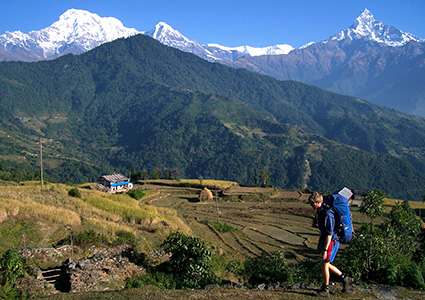

IFf you’re planning a trip to the Himalaya and are after a quick answer on when the best time to trek is, well, the answer is, “it depends”! Generally speaking, there is no absolute best time for everyone; your Himalaya experience will depend on how you feel about crowds, how high you are planning on trekking, and your tolerance for heat, cold and rain. Each Himalaya season has its own pros and cons, and with our handy guide you should be able to choose the trekking season best for YOU so you can get the most out of your trip.
Spring (March – May)
If you’re after warm temperatures, blossoming flora and temperate days, Spring is the ideal season to trek in Nepal. Early spring tends to be a bit chilly, with mild temperatures in the low elevation regions (800-2000m), making trekking in regions such as lower very pleasant. As winter fades away and spring pushes in, temperatures in regions with elevations over 4000m have moderate temperatures, making way for sunny, clear and warm trekking conditions.
Considered one of the best seasons to trek and climb in the Himalaya, spring brings not only with it the sun and warmer temperatures, but fields of blossoming wild flora such as the famous giant rhododendrons, giving the landscape a radiant and vibrant texture.
Summer typically brings the monsoon rains from late May to mid September in Nepal, so trekking during this time is not typically recommended in Nepal. With the monsoon comes high temperatures, considerable rain and uncomfortable conditions. Mountainous regions are usually enveloped in clouds, and the lower routes are generally muddy with large numbers of leaches.
Considered the best trekking season in
Nepal, it’s hard to fault the clear skies, moderate days and fantastic trekking conditions that autumn brings. After the monsoon the dust and pollution is cleared from the atmosphere, making way for crystal clear views and with it, stunning panoramas of the Himalayan mountain ranges.
Depending on the intensity of the monsoon, the best time to trek generally starts around mid September. Once the weather has settled, most days feature clear blue skies and a bright sun that lasts throughout the say, unlike in Spring, when cloud builds up in the afternoon. Towards December the evenings begin to cool off quite quickly, especially at higher altitudes, making warm trekking gear and sleeping bag a must!
Experience the best that the Annapurna region has to offer on the trek.
Book on the between for crystal clear skies and sublime panoramas.
For most people it is too cold to trek to high altitude regions in Winter in Nepal; daytime temperatures can range between 9-12ºC, and evenings can drop to sub zero temperatures. If the cold doesn’t bother you, it is a great time to trek to the more popular places such as the Everest region, because there are far fewer people around compared to October and November, as well as the lower to mid altitude trails, where the temperature remains fairly pleasant. Our Christmas and New Years treks in Nepal are always very popular for just this reason.
Mornings can start foggy, but afternoons are usually clear with the occasional snow in the mountains. With this in mind, high passes such as Thorong La (5416m) in the Annapurna region, and the Kongma La (5545m), Cho La (5335m), and Renjo La (5420m) in the Everest region are usually closed from late November to March.